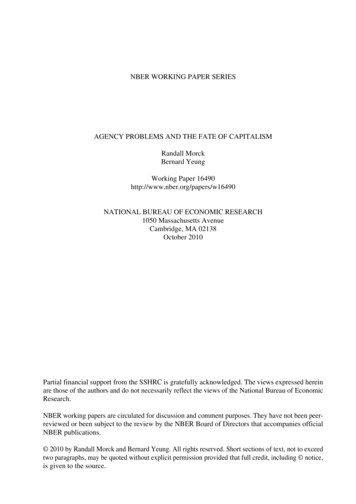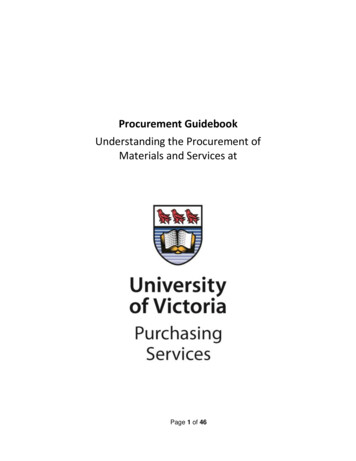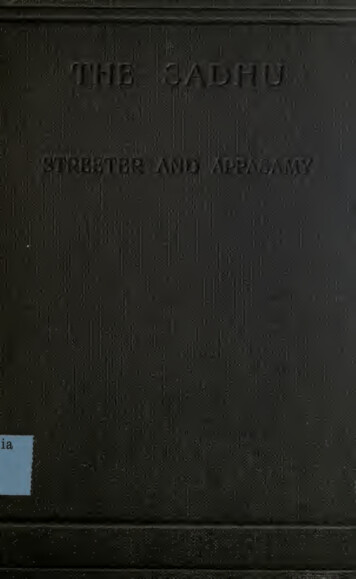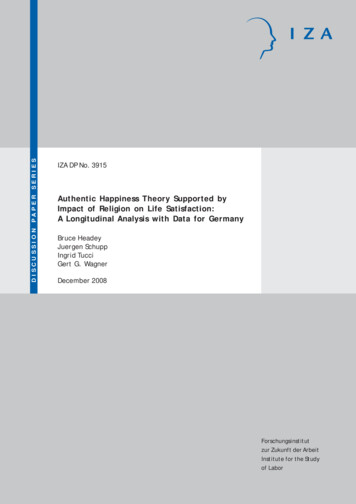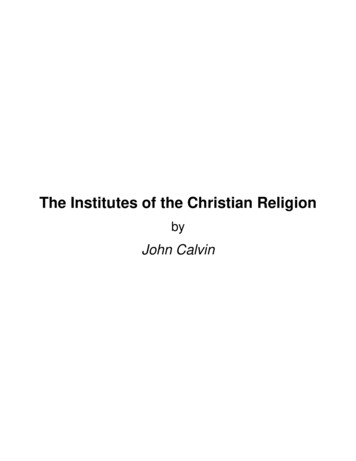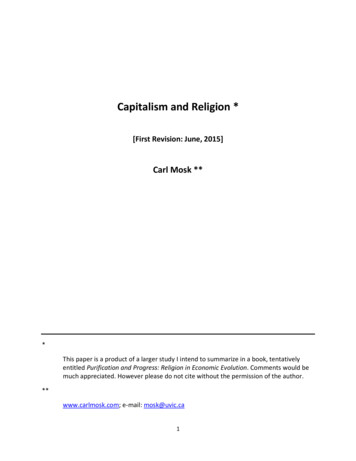
Transcription
Capitalism and Religion *[First Revision: June, 2015]Carl Mosk ***This paper is a product of a larger study I intend to summarize in a book, tentativelyentitled Purification and Progress: Religion in Economic Evolution. Comments would bemuch appreciated. However please do not cite without the permission of the author.**www.carlmosk.com; e-mail: mosk@uvic.ca1
AbstractThe essence of capitalism is credit creation driven by the mobility of capital; the essence ofreligion is purifying faith. Pervading the great religions of the Classical Era – Judaism, nascentChristianity, Greek philosophy, Buddhism, Confucianism, and Taoism - was contempt for themerchant, nascent capitalism’s agent. To priests domestic merchants were corrupters, impure;to rulers foreign merchants – notably the nomadic peoples of the Central Asian Steppesadhering to the Central Asian Complex – were potential military enemies. Ultimatelypummelled by invasions swirling out of Central Asian that terrified their elites, the greatcivilizations slipped into the Dark Ages, trade faltering. As the great civilizations recovered fromthe Dark Ages, the Central Asian Complex merged with Classical Era religions in two regions:Western Europe and Japan, spawning feudalism. Exploiting reviving opportunities for Eurasianwide trade, a new religion Islam emerged. It promoted capital mobility, putting down the rootsof Merchant Capitalism. To stay competitive Islam’s most fervent enemy, Western EuropeChristendom, gradually copied and adopted Islam’s innovations, notably the bill of exchange,laying the foundation for banks and stock markets. Drawing upon Greek learning as interpretedand updated by Islamic scholars, and exploiting domestic advances in manufacturing precisionmachinery, Western Europe slowly wedded Merchant Capitalism to a second form ofcapitalism, Technological Capitalism. Modern capitalism as we know it was born. All of thisoccurred in an era when religious faith was unshaken among the masses. However advances inTechnological Capitalism after the mid-19th century increasingly undercut the hold religiousfaith had on the masses, ushering in a revival of the conflict between capitalism and religiousfervor.2
“Disillusioned words like bullets bark/As human gods aim for their mark/Make everything fromtoy guns that spark/To flesh-colored Christs that glow in the dark/It’s easy to see withoutlooking too far/That not much is really sacred.” (It’s Alright, Ma (I’m Only Bleeding)” 1“You can’t take it with you and you know it’s too worthless to be sold/They tell you, ‘Time ismoney,’ as if your life was worth its weight in gold” (“When You Gonna Wake Up?”) 2“Jesus is calling, he’s coming back to gather up his jewels/Jesus is calling, he’s coming back togather up his jewels/We living by the golden rule, whoever got the gold rules” (Gonna ChangeMy Way of Thinking” Version 2) 3“You know, capitalism is above the law/It say, ‘It don’t count unless it sells’/When it costs toomuch to build it at home/You just build it cheaper someplace else” (“Union Sundown”) 4******In the first section I explain why the religions of the Classical Age were hostile to capitalism. 5IDistrusting Merchants, Classical Age Religions Constrain ViolenceI.APriests and Warrior-RulersThis is how a story from the Brahmanas, a compendium of ancient Hindu scriptures -known as “King and the Priest in the Chariot” - goes: 6“Vrisha was the royal chaplain . of Triyaruna, king of the Ikshvakus . [he would] holdthe reins in the chariot for the king . to keep him [the king] from doing any harm .asthe two of them were driving along, they cut down with the wheel of the chariot of thechariot the son of a Brahmin . they argued with each other about it. The king said ‘Theone who holds the reins is the driver of the chariot. You are the murderer.’ ‘No,’ said thepriest ‘I tried to pull back to avoid him, but you drove the horses on. You are themurderer.’”3
A second even more remarkable Hindu scripture, the Bhagavad Gita, describes anothergreat struggle between chariot driver (the god Krishna) and warrior-rider (Arjuna): 7“Arjuna .asks Krishna a lot of difficult, indeed unanswerable age-old questions aboutviolence and nonviolence, this time of the context of the battlefield, questioning thenecessity of violence for warriors .[ultimately] the warrior with ethical misgivings hasbeen persuaded that since war is unreal, it is not evil .Krishna persuades Arjuna tofight.[by offering him] devotion . [renouncing] not the actions but their fruits .[embracing] actions without desires.”*****To be sure these ancient myths are part and parcel of a worldview in which Brahmins(priests) and warrior-rulers (Kshatriyas) share ruling power, self described purified elites,lording over Vaishyas (merchants, farmers and herders) who are at least allowed to participatein purifying rituals and Shudras (servants, serfs) so impure as to denied access to the rituals.Indeed in the Vedic myth describing the dismembering of the Primeval Man: 8“His mouth became the priest (the Brahmin, master of sacred speech) . His arms werethee Raja (the Kshatriya, the Strong Arm, the class of warriors, policemen and kings); histhighs, the commoner (the Vaishya, the fertile producer .) and his feet – the lowest anddirtiest – the servants (Shudras) .”In effect a system of checks and balances existing among the ranks of the elites is beingdescribed in the myths surrounding Brahmins and Kshatriyas. Priests check the actions ofwarrior-kings prone to excessive violence. They check the excesses of rulers by appealing toguilt, reminding the powerful that wanton bloodshed leads to even more bloodshed. Warriorkings submit to priests because the priests provide them with justification for the actions theyare required to take in their official capacities. Armed with priestly rationalization, they garnerlegitimacy. The lower classes owe obedience to these elites because their joint rule permits the4
lower groups to function in a relatively peaceful market oriented environment where exchangeand barter flourish.Granted the stories are specific to Hinduism. Still they are emblematic of the way statesoriginally created norms encouraging cooperation in populations sufficiently large to enjoywidespread specialization and division of labor. Typically these states emerged as hunting andgathering tribal structures gave way to more complex societies enjoying the benefits of settledagriculture with domesticated plants and animals.9 Joint rule by priest and warrior elites appealto transcendental monitoring. Monopolizing contact with purity, elites purporting to be inclose contact with a transcendental world inhabited by gods and/or eternal philosophicalprinciples claim they inculcate norms of purity that counteract the pollution rife in amaterialistic world inhabited by merchants, farmers, craftspeople, servants, slaves and serfs.Alas, the elites are all too human. Try as they will to elevate themselves above mundanehumanity they are not gods. Over time they become increasingly corrupt, sullied by power andgreed, self righteous and arrogant. The veil of purity falls off their bodily frames. Increasinglyseen as hypocrites and spongers, resentment stirs among the masses. Overthrow from belowthreatens. But going down this road leads to more, not less, violence.The great religions of the Classical Age offer a solution: a hero anointed to be messengerby an even higher transcendental authority comes, bearing a new and more compellingmessage than that offered by the contaminated priesthood: purity can be won by anyone, bythe masses themselves. The gates to purity are being swung wide open beckoning everyone tocrowd in one and all.5
The so-called Axial religions – Confucianism, Taoism, Buddhism, the books of theHebrew Prophets, Christianity – emerged on the Eurasian land mass in the last millenniumBCE.10 Despite marked differences between these faiths, they share common features:purification through ritual and the inculcating of myth; the existence of an identity figure, thehero, who shining example can emulated by the faithful; diversity in the paths that be soughton the road to purity; and the potential to incorporate earlier forms of religious worship,syncretism.Why did the religious hero emerge?I.BDomestic Merchants Garner Low Status in the pre-Axial AgeIn the pre-Axial faiths merchants were distrusted, despised. They dealt in the material,the obverse of the transcendental. Trading in un-standardized commodities – diverse in sizeand weight, myriad in design and texture – they were as likely as not to oversell their wares, tolie and dissemble as they haggled over price. They corrupted elites, encouraging their superiorsto anoint themselves in fragrances, to dress in silk, to display their exalted status with emeraldpendants, jade rings, and glistening babbles. Their labors were clothed in deception; theyencouraged greed; they fomented invidious envy.Emerging out of the ranks of the domestic populace the merchant was treated withopprobrium. The obsequious merchant dealing in local commerce was not especially feared,just held in contempt. To be sure the artisan who fabricated ploughs and wove fabrics and thetiller of the soil were also objects of derision. However provided they paid their taxes andtithes, accepting the fact their status was lowly, bowing their heads before the priests and6
warriors who sanctified their societies, they were viewed as either too stupid or downtroddento threaten the ranks of the elites. The sole threat was the crafty merchant, dissembler andclever, the amasser of wealth. Insufficiently humble the merchant might stir up the masses.Still uppity merchants emerging from the ranks of the lower classes could be managed.Keep them from gathering in weapon caches. Radically different was the problem posed by thelong-distance merchant: the herder of livestock, the nomadic merchant-warrior of the CentralAsian steppes. This individual was the proto-capitalist, exclusively dealing in mobile capital,driving on livestock in search of feeding grounds. Threatening the great agrarian civilizations asthey came swirling out of the steppes in spoke wheel chariots these merchant-warriors wereprepared to trade horses for elegant textiles, for golden goblets, for jewels. These were thechariot riders celebrated in the Rig Veda. Treated with disrespect they could turn dangerous,seizing territory, unseating rulers, and trashing temples. No wonder the Vedic literature makesrepeated reference to the horse sacrifice. The horse epitomized the wildness of the steppe.The age of chariot warfare was bad enough. But it was nothing compared to the threatthey posed once the Iron Age promoted advances in archery. By 1000 BCE merchant-warriorscould flex their muscle massed in huge cavalries. With the onset of the Iron Age the technologyof warfare took a leap forward. A small bow – the “cupid bow” – coupled with cast bronzearrowheads produced on mass basis according to standardized weight and size – changed all ofthis. 11 Arrows were simplified and streamlined. Armed with a small bow that could be flexiblyoperated by archer riding atop speeding horseback the merchant-warrior was able to dispatchmetal tipped arrows in three directions: left, backwards and forward. Forged into armies7
through loyalty to powerful chieftains who entered into alliances of convenience with potentialrivals, the long-distance merchant band capable of carrying goods between the eastern andwestern reaches of the Eurasian land mass posed a whole new set of political problems for thegreat agrarian civilizations.Right upfront was the direct threat to military security. Second and only slightly lessdisturbing was the power of beliefs: the Central Asian chieftain came enshrined in the heromyth. This had tremendous appeal to potential domestic opponents of the priest/warrior elites.As well it had tremendous appeal to warrior-rulers: rule through a cult of violence. How tocheck this?Enter the religious hero.I.CThe Long Distance Merchant-Warrior: The Cults of the Central Asian Culture ComplexThis is the myth basic to the Central Eurasian Complex. It is the story of a hero: 12A maiden is impregnated by a heavenly spirit of god.The rightful king is deposed unjustly.The maiden gives birth to a marvelous baby boy.The unjust king orders the baby to be exposed.The wild beasts nurture the baby so he survives.The baby is discovered in the wilderness and saved.The boy grows up to a skilled horseman and archer.He is brought to court but put in a subservient position.He is in danger of being put to death but escapes.He acquires a following of oath-sworn warriors.8
He overthrows the tyrant and re-establishes justice in the kingdom.He founds a new city or dynasty.*****Loyalty unto death was central to the early Central Asian Culture Complex.12 The oathsworn friends of the hero were prepared to die for their lord. Even more striking, in theinstitution of the comitatus, the Praetorian guards, the defenders of the hero were prepared tocommit ritual suicide if the hero preceded them in death. The Japanese samurai who were heirsto the Complex knew this principle. They called it junshi. Loyalty was all: loyal retainers provedtheir devotion by following their lord into the grave, where they were buried with his weaponsand riches.Why embrace this horrid fate? The answer is riches: silk robes laced in gold, jewels, aluxurious life enjoyed in the palaces maintained by the lord. Indeed this was the key to trade onthe Central Asian steppes: the comitatus carried on trade in order to secure the beautifullycrafted ornaments produced in the civilizations that had embraced settled farming. As well thebond between chief and retainer ran deep. It gave purpose to life. In any case a life spentsurrounded by riches was superior to scratching out a penurious existence in villages strungacross the vast semi-arid interi
Trading in un-standardized commodities – diverse in size and weight, myriad in design and texture – they were as likely as not to oversell their wares, to lie and dissemble as they haggled over price. They corrupted elites, encouraging their superiors to anoint themselves in fragrances, to dress in silk, to display their exalted status with emerald pendants, jade rings, and glistening .
